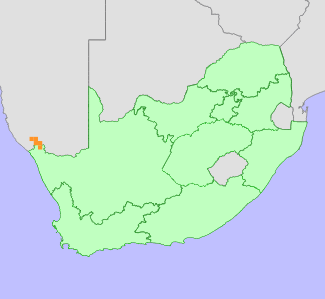|
Scientific Name | Tylecodon hallii (Toelken) Toelken |
Higher Classification | Dicotyledons |
Family | CRASSULACEAE |
Synonyms | Cotyledon hallii Toelken, Cotyledon pearsonii Schönland (in part), Cotyledon racemosa E.Mey. ex Harv. (in part) |
National Status |
Status and Criteria | Vulnerable A4ace |
Assessment Date | 2022/08/13 |
Assessor(s) | P.C.V. Van Wyk, N.A. Helme & D. Raimondo |
Justification | A range-restricted species with an extent of occurrence (EOO) of 4177 km², but previously common locally, the population has declined due to the impacts of drought, livestock farming, and mining. Given future climate declines are likely to continue into the future. An overall decline of 30 - 40% of the population is suspected to take place over a shifting time period of 90 years (three generations) starting in 1990 and ending in the year 2080. It therefore qualifies for listing as Vulnerable under criterion A. Given that the population in Namibia is also suspected to be declining as a result of mining and drought the regional status is not adjusted. |
Distribution |
Endemism | Not endemic to South Africa |
Provincial distribution | Northern Cape |
Range | This species has a restricted distribution in southern Namibia to the eastern Richtersveld. |
Habitat and Ecology |
Major system | Terrestrial |
Major habitats | Desert, Succulent Karoo |
Description | It occurs in exposed rocky slopes. |
Threats |
| Approximately 5% of the South African portion of its range falls within the Lower Orange River mining licensed area where there is ongoing loss of habitat, and subpopulations as a result of mining activities. There is also mining activity happening within its range in Namibia. Furthermore the population is declining due to climate change. Its entire range has experienced below average rainfall since 2012. Predictions of future climate change include further increases in annual average temperature of between 1.4°C and 2.4°C by 2050, which will result in unbearably hot temperatures and ongoing aridification throughout significant portions of the year (Van Wilgen et al. 2017). Since it is poisonous to livestock mature individuals are removed from their habitat by livestock farmers. |
Population |
This species was common across the eastern Richtersveld between Sendelingsdrif and Steinkopf, but during the severe drought years of 2016 - 2020 significant mortality was noted in the South African portion of the range, with many subpopulations experiencing between 30 and 50% mortality. The population has also declined due to the impacts of mining and livestock farming. This species is however currently recruiting well following some rainfall occurring in parts of its range, and it can recover based on a few good rainfall years, however climate models do predict ongoing aridification for the region it occurs in. An overall population decline of 30-40% is thus suspected over a shifting time window of three generations (90 years). In Namibia it is known from 10 to 20 subpopulations, and while noted to not be declining by Loots 2005, it is likely that it also suffered similar declines during the droughts that have taken place over the past decade, with future ongoing declines suspected.
|
Population trend | Decreasing |
Assessment History |
Taxon assessed |
Status and Criteria |
Citation/Red List version | | Tylecodon hallii (Toelken) Toelken | Least Concern | Raimondo et al. (2009) | |
Bibliography |
Loots, S. 2005. Red Data Book of Namibian plants. Southern African Botanical Diversity Network Report 38. SABONET, Pretoria and Windhoek.
Raimondo, D., von Staden, L., Foden, W., Victor, J.E., Helme, N.A., Turner, R.C., Kamundi, D.A. and Manyama, P.A. 2009. Red List of South African Plants. Strelitzia 25. South African National Biodiversity Institute, Pretoria.
Snijman, D.A. 2013. Plants of the Greater Cape Floristic Region 2: The extra Cape flora. Strelitzia 30. South African National Biodiversity Institute, Pretoria.
Tölken, H.R. 1977. New taxa and a new combination in the genus Cotyledon. Bothalia 12(2):191-194.
Tölken, H.R. 1978. New taxa and new combinations in Cotyledon and allied genera. Bothalia 12(3):377-393.
Tölken, H.R. 1985. Crassulaceae. In: O.A. Leistner (ed). Flora of southern Africa 14,1:1-244. Botanical Research Institute, Pretoria.
Van Jaarsveld, E.J. and Koutnik, D. 2004. Cotyledon and Tylecodon. Umdaus Press, Pretoria.
Van Wilgen, N.J. and Herbst, M. 2017. Taking stock of parks in a changing world: The SANParks Global Environmental Change Assessment. SANParks, Cape Town.
|
Citation |
| Van Wyk, P.C.V., Helme, N.A. & Raimondo, D. 2022. Tylecodon hallii (Toelken) Toelken. National Assessment: Red List of South African Plants version 2024.1. Accessed on 2025/12/08 |
 Comment on this assessment
Comment on this assessment


